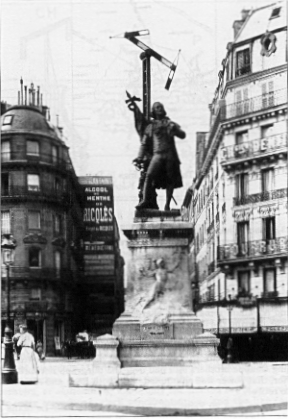 Claude Chappe
Claude Chappe Claude Chappe
Claude Chappe1763 AD: Birth of Claude Chappe, Grandson of a French Baron, trained for the church.
Loses his religious benefices in the wake of the French revolution in 1783. Decides to work with his brothers on the problem of the optical telegraph.
Pendulum clocks used at the end points (400 meters apart). 16 numerials on clock face. Message encoded as a sequence of numerials. When sending clock reaches the desired numerial to be sent next, a loud sound is made which can be heard at the receiver. Receiver clock face indicates the next numerial in the sequence. Agreed upon sound is used to cause the pendulum weights at the sender and the receiver to be dropped in synchrony. (Note: signal flags could be used as well as sounds.)
Considered using electrical means to transmit signals, but adequate insulation did not exist at this time.
Sought financial support from the Legislative Assembly to build an operational telegraph system in Paris.
Rectangular wooden frame with five sliding panels that could be displayed or obscured via pulleys. Implements a 5-bit binary code (32 combinations). A system very similar to this was eventually developed by the British and the Swedes.
A mob destroyed the experiment: suspected of being a subversive instrument meant to communicate with France's enemies.
1792 AD: Assembly replaced by the National Convention, Louis XVI placed in prison and the Republic declared. 1793 brings the Reign of Terror. Chappe maintains a low profile.
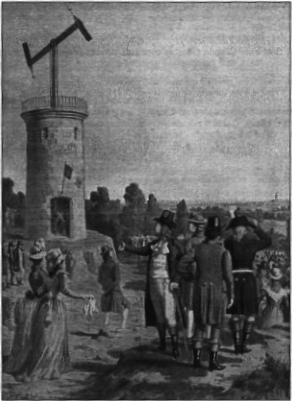 Horizontal beam (called the "regulator")
+ two smaller wing beams (called the "indicators"). Could be varied
in 45 degree increments. Claims that this is easier to see than the shutter
system.
Horizontal beam (called the "regulator")
+ two smaller wing beams (called the "indicators"). Could be varied
in 45 degree increments. Claims that this is easier to see than the shutter
system.
National Assembly votes 6000 francs to Chappe to build the system. First recorded use of the term telegraph: "far writing."
Three location selected, 15 km first hop and 11 km second hop
11 minutes to transmit the original 27 word message. Answer arrives 9 minutes later.
26 July 1793: decision to build a French state telegraph at a cost of 58,400 francs. 15 stations spanning from Paris to Lille (120 miles North of Paris).
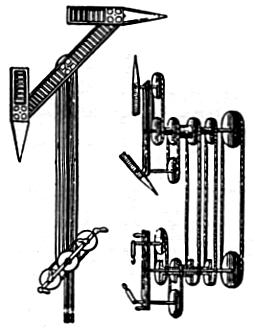 Breguet, the famous French watchmaker,
assists in designing the intricate pulley and gearing systems necessary
to operate the telegraph.
Breguet, the famous French watchmaker,
assists in designing the intricate pulley and gearing systems necessary
to operate the telegraph.
30 April 1794: Line completed and initial testing of the system.
16 July 1794: Line declared open.
15 August 1794: First official message: reporting recapture of the city of LeQuesnoy from the Austrians and the Prussions.
3 October 1794: A second line authorized from Paris to Metz/Strasbourg, on France's Eastern frontier.
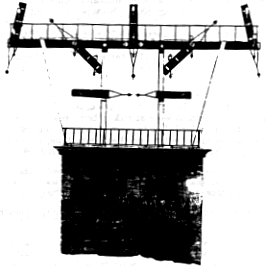 Improvements to the System
Improvements to the System1799: Napoleon seizes power. Sends the message "Paris is quiet and the good citizens are content." via optical telegraph. Declares himself Emperor in 1804.
By 1800, telegraph stations spread N, S, E, W from Paris across the whole country. Stations placed approximately 6 miles apart. By 1803, line began to be extended to Italy, Belgium. Completed in 1814.
Lines divided into short, autonomous segments called divisions. Messages decoded and logged at start and end of each division. Operators at intermediate stations did not know the complete code, only a subset of control codes.
1804: Government consistently late in providing funds for line construction. Adversaries attack his designs, claiming credit for themselves. Chappe falls ill on an inspection tour of the lines. Depressed, he commits suicide in 1805.
 Chappe's brothers continue to
develop and expand the system. Mobile semaphose system developed in 1812,
and still in use duing the Crimean War (1853 - 1856). Expansion within France
continues until 1853, when it is finally replaced by electric telegraph.
Chappe's brothers continue to
develop and expand the system. Mobile semaphose system developed in 1812,
and still in use duing the Crimean War (1853 - 1856). Expansion within France
continues until 1853, when it is finally replaced by electric telegraph.
Traffic averaged a few hundred messages per year. Grew to 556 stations covering 3000 miles linking the 29 largest French cities. Over 1000 people employed.
Need to guard the secrecy of transmissions.
1836: Operator bribed to introduce a specific pattern of errors into a transmission about the direction of the Paris stock market. Taken advantage of by accomplices in Bordeaux. System was circumvented at the Divisional boundaries.
Complex pulley and gear system controlled the position of the regulator and the two wings.
Virtually impossible to send messages in relay fashion with no errors.
Decimal encodings: 1-9: most frequent words, single signal; 10-99, two signals; 100 to 999, three signals; 1000 to 9999, four signals;

Note that the regulator is in either the horizontal or vertical position (no 45 degree variations), and only one of the indicators is used (again, no 45 degree variations are used).
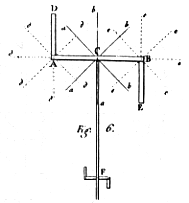 Could be extended to a base-20
number system as follows: precede with a prefix signal--regulator 45 degrees
right oblique or left oblique position. Former indicates odd number, latter
indicates even number. Could be used to reduce the number of symbols needed
to identify a phrase in a code book. Proposed, but never actually used.
Could be extended to a base-20
number system as follows: precede with a prefix signal--regulator 45 degrees
right oblique or left oblique position. Former indicates odd number, latter
indicates even number. Could be used to reduce the number of symbols needed
to identify a phrase in a code book. Proposed, but never actually used.
Note that the operators at stations inside the divisions only knew the numerials, not how these mapped onto actual letters and phrases.
Control signals: both indicators turned away to avoid ambiguity with the basic numerial codes.
 Question: What is the maximum
number of semaphore configurations, assuming that the regulator and the
indicators can be placed in arbitrary 45 degree positions?
Question: What is the maximum
number of semaphore configurations, assuming that the regulator and the
indicators can be placed in arbitrary 45 degree positions?
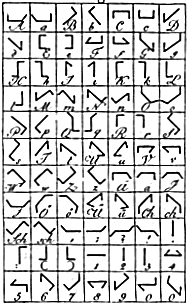 First part of the code: 94 different
signs to encode the alphabet, numerials, and frequently used syllables.
Set and confirmed by folding in the two indicators (called closing).
First part of the code: 94 different
signs to encode the alphabet, numerials, and frequently used syllables.
Set and confirmed by folding in the two indicators (called closing).
Second part of code: 94 pages with 94 symbols on each page. More symbols and common words. First signal gives line number, second signal gives page number.
94 + 94 x 94 = 8930 words and phrases.
Question: Chappe added three additional parts to the code. How did he do it?
First and second parts used two signals; third and fourth used three; fifth used four.
First step: formation of signal
Second step: confirmation/completion of the signal
Third step: close the signal
Message signals formed on the left oblique. Control signals formed on the right oblique.
Each signal passed one at a time from one end of the system to its destination. Operator must verify that next station in the system correctly reproduced the signal. Otherwise send error signal.
Destination |
Stations |
Time (sec) |
Time/Station (sec) |
|---|---|---|---|
| Calais | 27 | 180 | 6.7 |
| Brest | 80 | 480 | 6 |
| Lille | 22 | 120 | 5.5 |
| Strasbourg | 45 | 390 | 8.7 |
| Lyon | 50 | 540 | 10.8 |
| Total | 224 | 1710 | 7.6 |
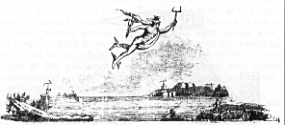
Letterhead Used for Telegrams
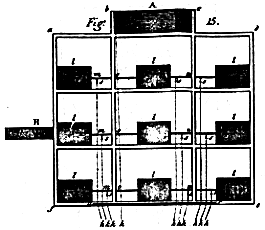
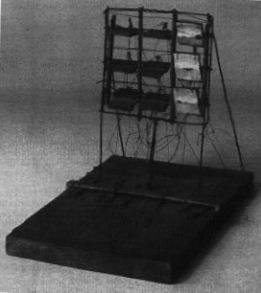
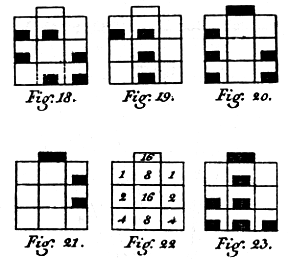 1795 AD:
Swedish Aristocrat Edelcrantz designs a matrix of 3 x 3 shutters, with a
10th extra large shutter on top. First link went from Stockholm to the Fortress
of Vaxholm. Spreads quickly through Sweden, driven by fear of invasion during
the Napoleonic Wars.
1795 AD:
Swedish Aristocrat Edelcrantz designs a matrix of 3 x 3 shutters, with a
10th extra large shutter on top. First link went from Stockholm to the Fortress
of Vaxholm. Spreads quickly through Sweden, driven by fear of invasion during
the Napoleonic Wars.
Used octal encoding: from top to bottom 1, 2, 4. Each column represents a signal number in the range 0 through 7. Full telegraph could send 000-777 and A000-A777 if 10th shutter is closed.
1809 AD: Swedish network involves 50 stations spread across 124 miles.
1881 AD: Last optical telegraph closed in Sweden.
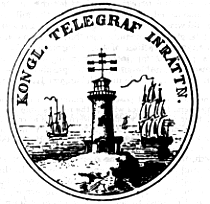
Seal of the Royal Telegraph Institution